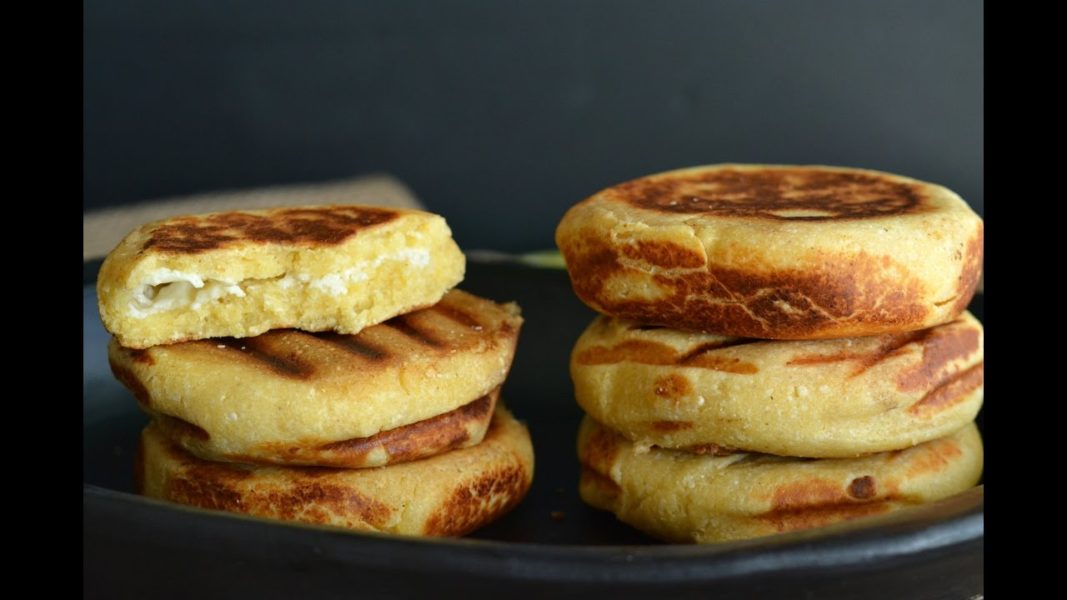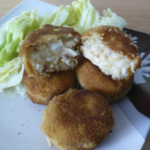The arepa is a round bread of indigenous origin typical of America.S Recently, this food has become very popular around the world due to the emigration of Venezuelans and many people think that it is possibly here to stay, just as other international foods did at the time. However, although at present the arepa that appears the most is the Venezuelan, this food is also consumed in other countries, but not in all of them it receives the same name, and in each one this food has its particularities. As for its origin, it could be shared between Colombia and Venezuela, since both have consumed arepa since the pre-Columbian period and it is very difficult to trace who made it first, since at that time they were part of the same territory.
The arepa is delicious in all its expressions and each place puts its own style on it, that’s why we want you to know the main types of arepas and enjoy the one you like the most as much as we do. When is it appropriate to taste a tasty arepa? On any occasion, be it as an aperitif, appetizer, at breakfast, at dinner or as a companion to meals (only bread type). Discover how to make arepas in all its versions!
How to make arepas?
Generally, arepas are made with corn or wheat flour. However, as we will see in the section corresponding to Colombian arepas, the dough can vary considerably. Starting with the traditional recipes, as we say, we distinguish the following:
- Corn flour arepas
- Wheat flour arepas
On the other hand, we currently find a whole variety that allows us to make original homemade arepas, healthy and for all tastes. For example, we can make arepas with oatmeal, beets, and even rice
Coconut arepas
- Beet arepas
- Oat arepas
- Rice arepas without flour
- Green plantain arepas
- Sweet potato arepas
- Chia arepas
- Pumpkin arepas
- potato arepas
- Carrot arepas
Types of Venezuelan arepas
Classifying the different types of arepas from Venezuela is not an easy task, since there is not yet a reliable record that brings them all together, so it is difficult to specify how many there are, although there are those who say that there are between 40 and 80 varieties.
For everything said above, we will only focus on the main stuffed arepas, as these define the Venezuelan style a lot. It is interesting to mention that, if you eat an arepa in a food place in Venezuela, you can ask for it mixed (a personalized arepa) and add sauces to taste, commonly guasacaca or spicy. That said, let’s see how some Venezuelan arepas are classified:
- Pepied queen. The filling consists of a cream prepared with shredded chicken or hen meat, mashed avocado, mayonnaise or Greek yogurt. In addition, avocado slices are added.
- Sifrina. It has the same content as queen pepiada, but it also contains yellow cheese.
- Furry orhairy it consists of shredded or shredded beef (tinga de res) and grated white cheese.
- Catira. Contains shredded chicken and grated cheese.
- Dominoes. This type of Venezuelan arepa is named for the combination of colors provided by its filling ingredients, black beans and white cheese, which remind us of the pieces of that famous game.
- Creole Pavilion. This arepa has the typical ingredients of the iconic dish of Venezuelan gastronomy: shredded beef, slices (fried plantains), grated white cheese and black beans (black beans).
- Llanera. This Venezuelan arepa is filled with shredded roast beef, sliced avocado, sliced tomato, and grated Guiana or white cheese.
- Gringa or musiúa. It is called that because its ingredients are the same as those used for a traditional hamburger (meat, vegetables and sauces), although the bread is replaced by an arepa.
- Santa Barbara. It contains a beef steak accompanied with cheese and avocado.
- Rumbera. It consists of an arepa stuffed with pork and grated cheese.
- Tumbarranchos. For this preparation, an arepa from the day before (known as tostadas) is used, which is filled with mortadella and fried. In addition, it is accompanied with sauces, cheeses, meats and vegetables.
- Mattress breaker. This delicious type of arepa is filled with a mixture of seafood.
- On horseback. This is what it is called when the arepa has a fried egg on top.
- Deviled arepa. The filling consists of ground and canned pork. She is said to be deviled by a famous brand.
- Parakeet. This arepa is filled with a scrambled egg with tomato, onion and sweet pepper.
- Arepas with cheese. There is a great variety, because in Venezuela there is a wide range of cheeses, mostly of the fresh type. The most popular arepas in this region are those with yellow cheese, guayanés cheese or telita cheese. In addition, this combination can be buttered or not, and the cheese is used grated or in a thick piece.
- Arepa with ham and cheese. Contains cooked ham, mozzarella or Gouda cheese. Some people also add boiled egg to it.
- Arepa with slice. This appetizer shows the typical salty-sweet Venezuelan flavor, with a combination of slices (ripe plantains) with fresh white cheese.
- Arepa with quail eggs. Quail eggs are mixed with pink sauce before being added to the arepa.
- Arepa with stripe. It consists of shredded or shredded stewed ray meat.
- Arepa with dogfish. The content is prepared in the same way as the skate, shredded meat type.
- Arepa with tuna. The filling of this arepa consists of a mixture of tuna, tomato, onion and mayonnaise.
- Arepa with pork salad. It has slices of baked pork, tomato slices and mayonnaise. After December 24, in Venezuelan homes it is usually a recipe for use, since the remains of pork from dinner serve as a filling for these arepas.
- Arepa with chicken salad. The salad can be simple (mayonnaise, potatoes, and carrots) or the full recipe used at Christmas. This preparation in December, in many Venezuelan homes, is also used as a recipe for the “day after”.
- Other traditional stuffed Venezuelan arepas: shredded meat (sometimes they add cheese), ground meat, black roast, with viscera (liver and gizzard, etc.), with sausages (chorizo, sausage or mortadella, mixed with a sauce), shredded chicken stew etc.
- Gourmet arepas: stuffed with lamb, sockeye salmon, shrimp, and avocado, etc.
Types of Colombian arepas
As with Venezuelan arepas, there is no established classification that serves as a definitive guide, but it is presumed that there may be between 40 and 80 types of Colombian arepas. It is interesting to mention that there are many similarities between Colombian and Venezuelan arepas, as you will be able to verify below, however, there are also important differences that define the identity of each place. That said, we invite you to explore the Colombian varieties of this delicious Latin American culinary expression:
- Corn arepas. The arepa de choclo is prepared from grains of tender corn, milk, sugar and salt. Thus, a product similar to a pancake is obtained, since its texture is spongy and its flavor is somewhat sweet. This preparation is filled with peasant cheese and is the sister of the Venezuelan cachapa, which is identical, but is filled in more diverse ways, although in Venezuela many do not properly consider it an arepa.
- Boyacá arepa. This appetizer stands out for its peculiar flavor, which mixes sweet and salty, a characteristic that makes it very similar to some kinds of Venezuelan arepas. To make the boy cense arepa, a dough is prepared with precooked corn, wheat flour, panela, salt and curd, then it is shaped and cooked on a grill or clay oven. It serves as an accompaniment both in lunches with meats and in breakfasts.
- Arepa paisa. This threshed corn arepa is characterized by two things: it does not contain any filling and its thickness is very thin. Once ready, it is served by spreading it on top with butter and, later, covering it with white cheese. It also works as a companion to foods such as chorizo.
- Valleuna arepa. The arepa valluna and the arepa paisa are practically the same, although they differ mainly in two things: the thickness and the moment in which the companions are added. The valluna is thicker than the paisa, it is usually cooked on a wire grill and, just halfway through cooking, the butter and grated cheese are added.
- Coastal arepa or egg arepa. It consists of an arepa made with yellow corn, which is precooked in oil, then a hole is made, the raw egg is added and it is fried again. In Venezuela, specifically in the state of Zulia, this type of arepa is also prepared.
- Arepa de chicharrón or arepa from Santander. This appetizer consists of a dough prepared with the following ground ingredients: preferably yellow corn (peeled and cooked), pork rinds and cooked yucca. Once the dough is ready, it is shaped into an arepa and cooked on a griddle with ashes dissolved in water (the secret touch of this preparation). It is commonly served as a side to soups and scrambled eggs. In Venezuela there are also chicharrón arepas, but the preparation can vary depending on the region.
- Stuffed arepas. The stuffed arepa is also present in Colombian gastronomy, although in a more punctual way and not as usual as in Venezuela. The most common fillings are meat, chicken, bacon, avocado, ripe plantain, and chorizo. Sometimes, accompanied with onion, paprika and coriander.
Other types of arepas
Although the main exponents of the arepa are Venezuela and Colombia, this food is also part of the culinary heritage of many other countries, in some due to cultural exchanges and in others due to their indigenous cultural heritage. For this reason, below, we have gathered the most recognized, although there are probably many other types of arepas:
- Canary arepas. The Canarian arepa is identical to the Venezuelan arepa and arises as a product of a very special connection between both places (especially Tenerife), due to the emigrations that took place at different times until the present and the consequent cultural exchanges. In the bars and restaurants of the islands they usually prepare them fried and, many times, they incorporate ingredients from the local gastronomy, such as soft cheese or Canarian banana.
- Panamanian tortilla or arepa. It is an old corn dough to which, depending on taste, you can add plantain or grated cheese and then cook it roasted or fried. They also have another variant called change or changa tortilla, prepared with new corn, which is characterized by its large size. This type of arepa closely resembles the Venezuelan and Colombian arepa.
- Pupusas. The pups is very similar to a thick arepa and is made with corn or rice dough. It is commonly stuffed with a wide variety of ingredients, especially local ones. It is said that it could have its origin in the Quiche Mayan culture. This food is consumed in Guatemala, Honduras and El Salvador. The usual fillings are loroco flower, suckling pig, pitos, cipolin leaves, blackberry herb, spinach, squash, ham, chicken or beef, etc.
- Chubby. Although the gorditas are not recognized as arepas, they have all the characteristics of these. It is a corn or wheat tortilla that is prepared in different ways: they are filled before cooking, they are opened to fill them after cooking or they are served with the filling on top. This Mexican appetizer is cooked fried or directly on the Comal and can be sweet or salty. It is interesting to mention that in Yucatan there is a cookie sprinkled with sugar and prepared with corn flour called arepa.
- Puerto Rican arepas. This type of appetizer is very similar to the Venezuelan Andean arepa prepared with wheat. Both can be eaten sweet or salty.
- Cuban arepas. Although it is called that, in Cuba they really refer to a pancake (crepe or pancake), prepared in the traditional style. Something similar happens with the tica or Costa Rican arepa.
Finally, although the arepa is not native to Peru, it is now eaten there, even with indigenous fillings.



